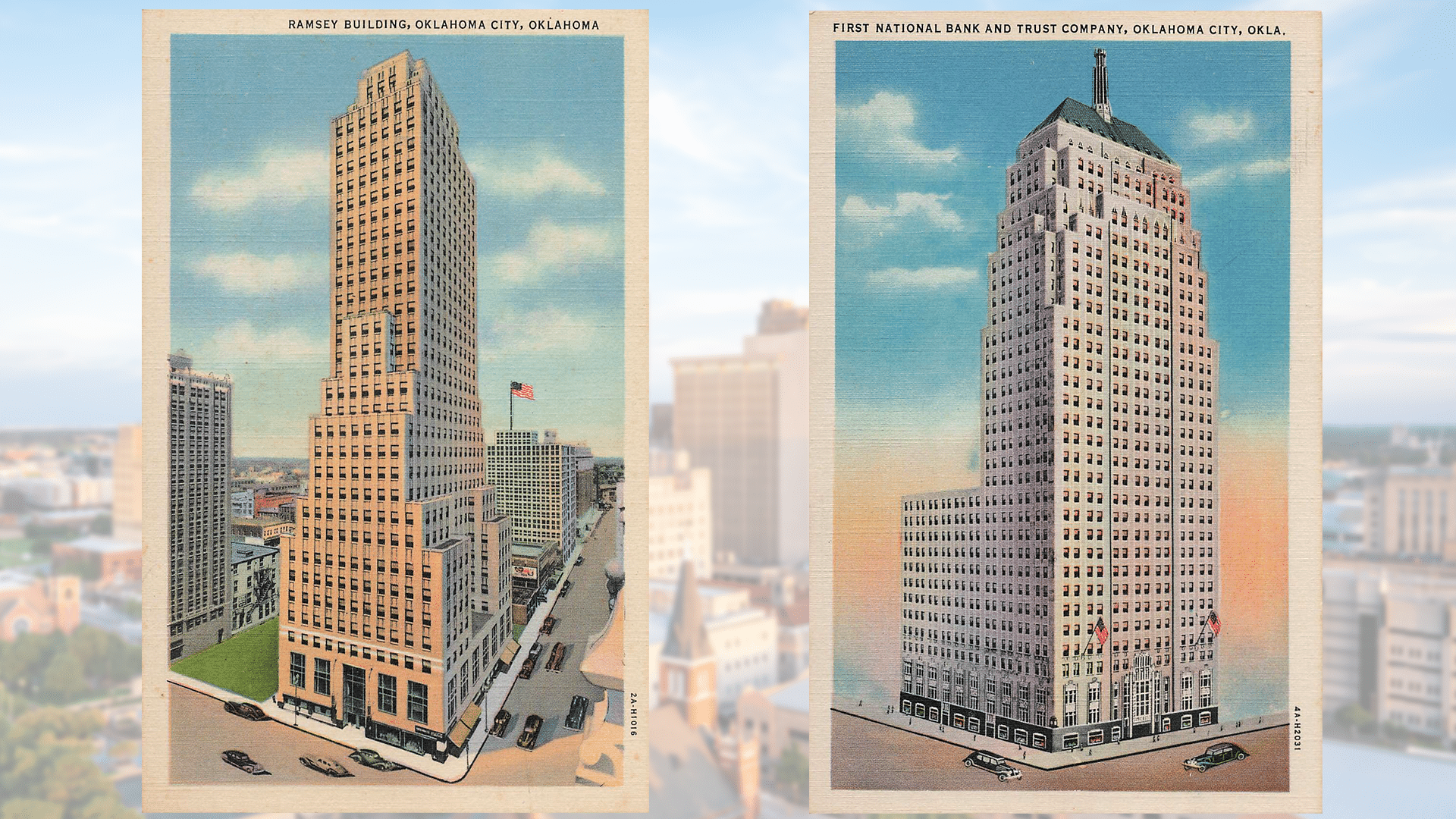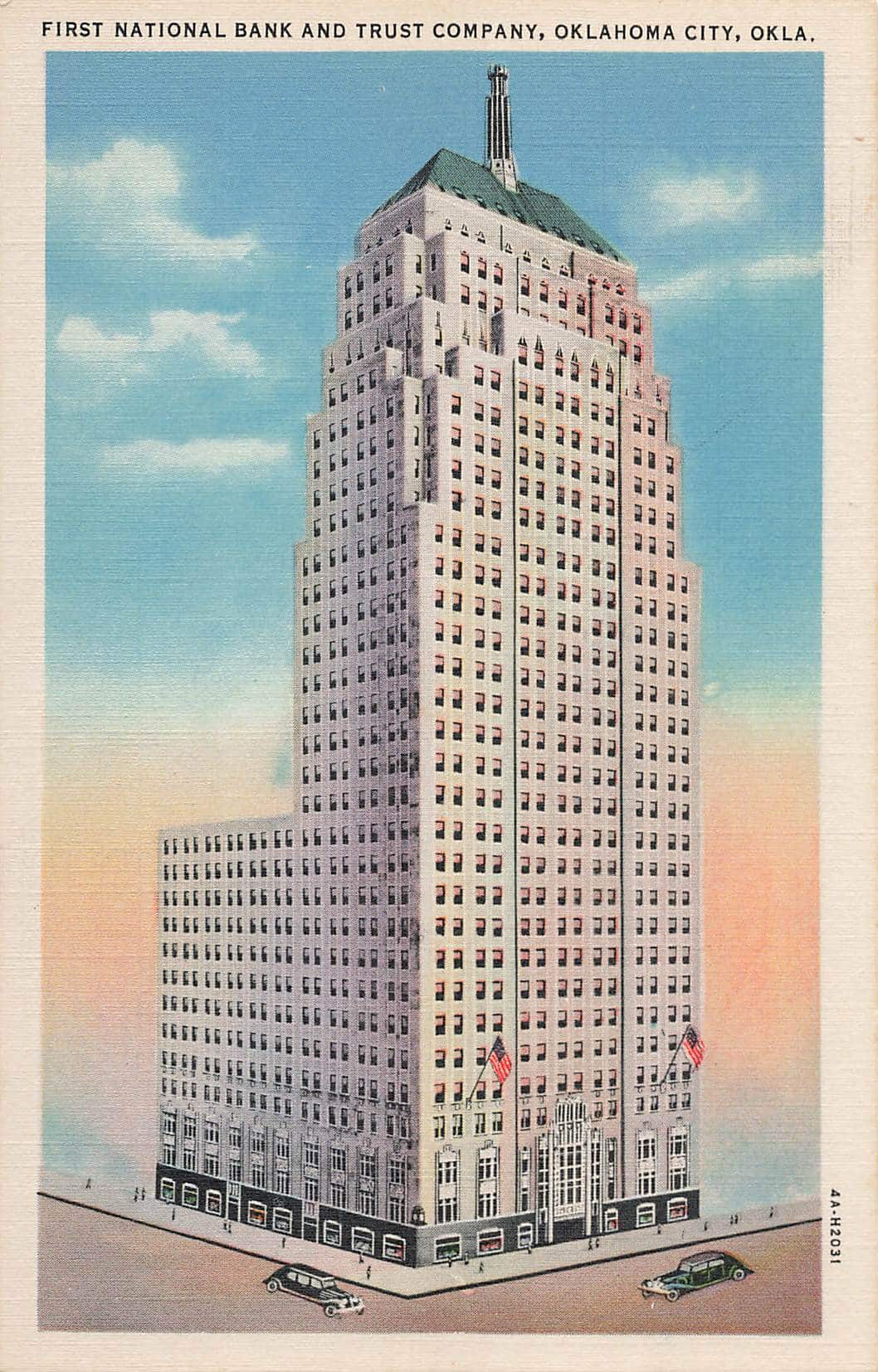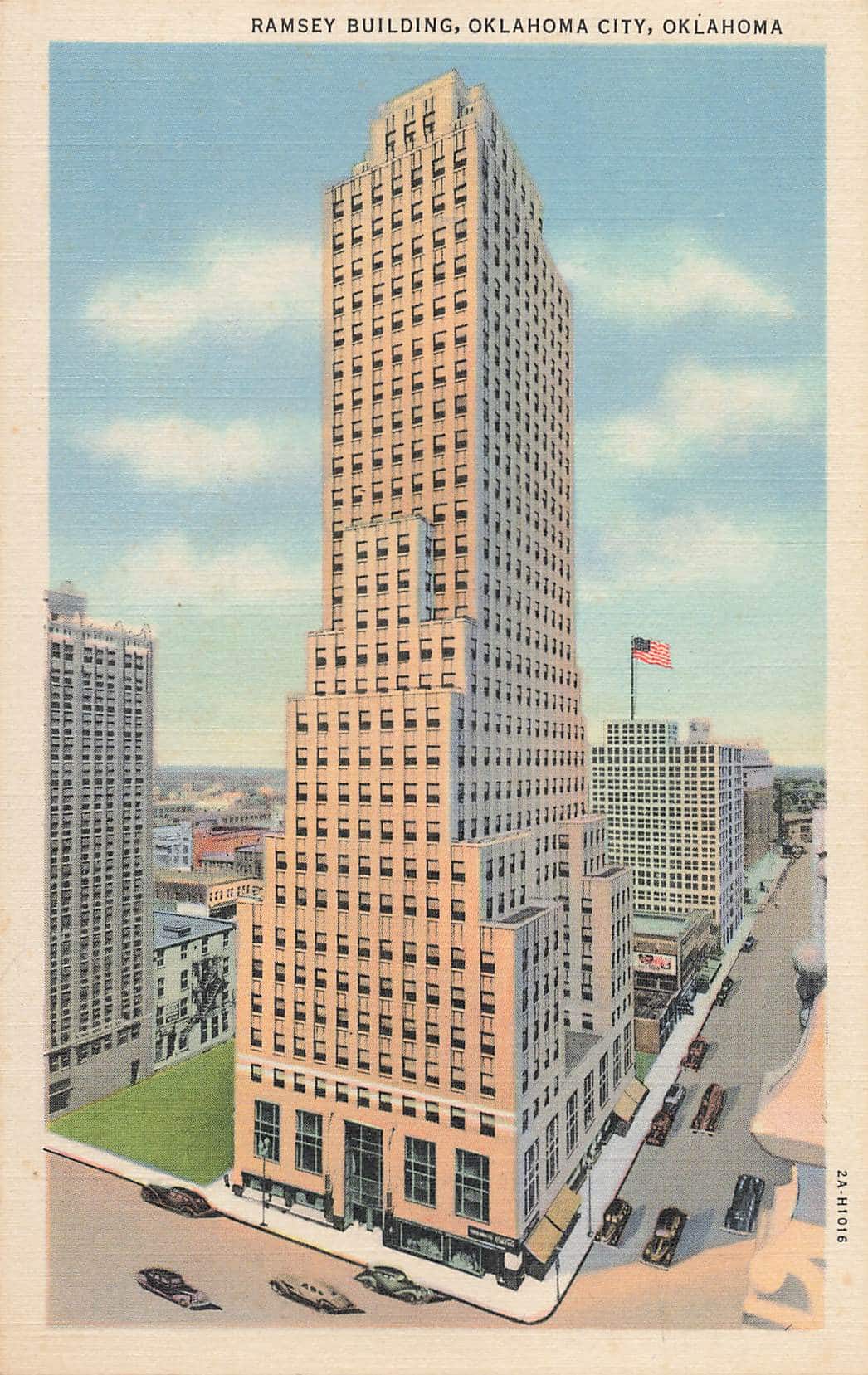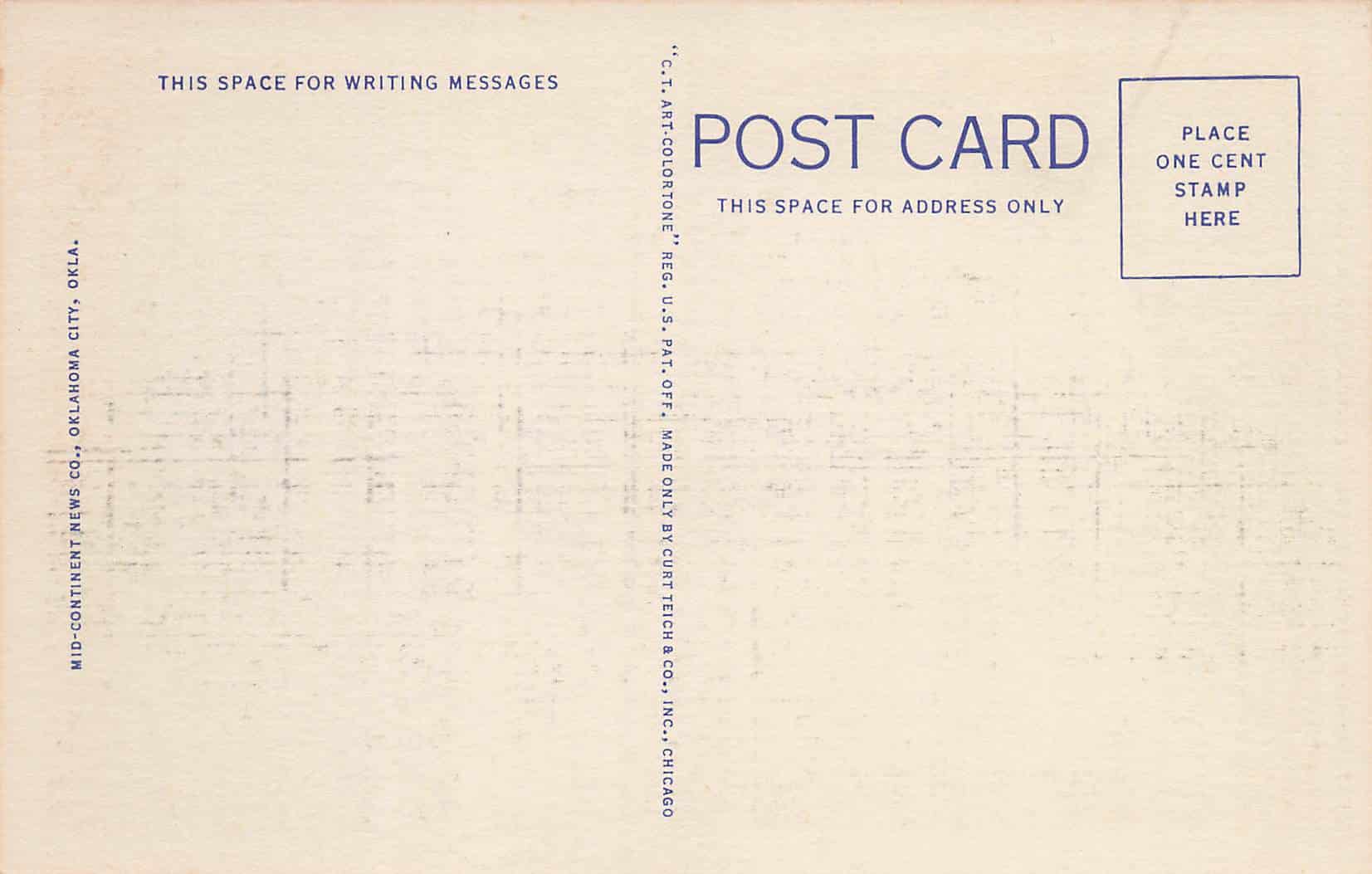
Oklahoma City Skyscraper Race 1931: Ramsey Building vs First National Bank Building Showdown
From my Oklahoma City postcard collection…
In the midst of the Great Depression, the Oklahoma City skyscraper race began race to the sky between two architectural monuments that would shape its skyline for decades to come. In 1931, the city found itself in the throes of a skyscraper rivalry as construction on the Ramsey Building and First National Bank Building went head to head. This competition not only offered a glimpse into the architectural preferences of the era, but it also provided a much-needed sense of optimism in an otherwise dreary economic climate.

The Ramsey Building, financed by the flamboyant oil tycoon W.R. Ramsey, was conceived as a symbol of luxury and prosperity. It boasted an Art Deco style, reflective of the popular design trends of the time. However, its competitor, the First National Bank Building, achieved even loftier heights. Developed as the headquarters of one of Oklahoma City’s oldest and most influential banks, the imposing structure featured a blend of Neo-Gothic and Art Deco elements that distinguished it from other buildings in the area.

Despite being conceived amid financial turmoil, the skyscraper race between the Ramsey Building and the First National Bank Building ultimately became an enduring symbol of Oklahoma City’s resilience and ambition. To this day, these buildings stand tall as lasting reminders of an era of architectural ingenuity and the unrelenting spirit of a city determined to reach for the sky.
Historical Context of the Oklahoma City Skyscraper Race
Oklahoma City in the Early 20th Century
Oklahoma City saw a period of significant growth and expansion in the early 20th century, following Oklahoma’s statehood in 1907. The city’s economy boomed, attracting a diverse range of industries, including agriculture, manufacturing, and oil production. This rapid growth put Oklahoma City on the map, turning it into a bustling urban center.
During this time, the city experienced a surge in development, driven in part by wealthy businessmen who made their fortunes in the oil industry. With this wealth came the desire to showcase the city’s success, leading to the development of imposing and impressive architecture throughout the city.
Birth of Skyscrapers in Oklahoma
One symbol of this optimism and progress in Oklahoma City was the construction of skyscrapers. These towering structures were built to accommodate the growing population and business needs. They also served as a testament to the city’s ambition and growth.
In 1931, the Ramsey Tower and First National Bank building began construction, sparking what became known as the “Great Skyscraper Race.” These two buildings were the epitome of Oklahoma City’s boom, with both vying to become the tallest and most impressive structures in the city.
The race attracted widespread attention as these structures rose, symbolizing the city’s ambitions and rapid economic growth. As a result, the construction of these two skyscrapers not only transformed the skyline of Oklahoma City but also demonstrated the progress that had come in such a short period since statehood.

The Race to the Sky
Competing Projects – Ramsey and First National
In 1931, downtown Oklahoma City witnessed a fierce competition between two ambitious developers, a banking giant and an oilman, who aimed to construct the city’s first skyscraper. Both the Ramsey Tower and First National Bank Building race towards the sky was a notable event during the Great Depression. The developers behind these two projects had big dreams and meticulously planned the execution to ensure they attained the tallest building title.
The Ramsey Tower, financed by oilman W.R. Ramsey, went toe-to-toe with the First National Bank project. These rivals poured millions into their respective developments, ensuring that their architectural marvels would stand tall and proud.
Architectural Marvels of the Era
Both towers showcased impressive design and boasted immense height for their time, which spoke to their architects’ expertise. The creators behind these compelling structures aimed to make a strong statement and leave a lasting impact on Oklahoma City’s skyline.
This section of Oklahoma City’s history is beautifully captured in the details of these two magnificent skyscrapers, whose creators strove to ambitiously redefine the landscape and bring forth a sense of pride and accomplishment for the city’s residents.
Legacy and Impact
Influence on Oklahoma City’s Skyline
In 1931, the completion of the Ramsey Building and the First National Bank Building forever changed the skyline of Oklahoma City. As two of the tallest structures of that time, they were a testament to the rapid growth of the city. The downtown area became a symbol of progress and modernity, attracting attention from across the United States.
The race between the Ramsey Building and the First National Bank Building was one of architectural excellence and construction prowess. The architect’s vision for each building showcased a significant leap in innovation, driving Oklahoma City’s development as an urban center. This race between the two skyscrapers even led to the construction of the Devon Energy Center years later, which now stands as the tallest building in Oklahoma City.
Cultural and Economic Impact
The Ramsey Building and the First National Bank Building, as two of the tallest downtown constructions in Oklahoma City in 1931, greatly contributed to the cultural and economic growth of the city. These iconic high-rises attracted businesses, tourism, and investments, spurring the local economic activity.
The architectural styles of the two buildings were a visual representation of Oklahoma City’s prosperity and sophistication. They became landmarks and points of pride for the residents, drawing attention from a broader audience in the process. This interest ultimately fueled further investments in the city, both culturally and economically.
The legacy of the 1931 skyscraper race in Oklahoma City can still be observed today. The Ramsey Building and the First National Bank Building’s architectural and design influence remain an integral part of the city’s skyline. As Oklahoma City continues to grow in size and stature, the lasting impact of these two buildings remains a testament to their historical significance.
Modern Developments and Future Visions
Current Projects and Outlook
With the growth of Oklahoma City’s skyline, new projects are surfacing that continue to drive the city’s development progress. Among these projects, Legends Tower stands out, envisioned by Matteson Capital, a renowned developer from New York. This ambitious project aims to create a residential tower reaching a staggering height of 1,907 feet. The potential addition of this iconic skyscraper certainly mirrors the historical race between the Ramsey Building and The First National Bank Building back in 1931.
The First Residences at First National offer a unique blend of historical charm and modern luxury in the heart of Oklahoma City. Housed in the iconic First National Bank Building, now reimagined as a mixed-use development, these apartments provide an upscale living experience. Residents can choose from a variety of spacious floor plans, which range from cozy studios to expansive three-bedroom units, ensuring an option that suits different lifestyles and needs (Apartments.com). The building itself, renovated in 2022 and soaring 33 stories high, features 195 units, combining contemporary amenities with the elegance of a bygone era (Apartment Finder). This landmark luxury high-rise living within the First National Center is now leasing, offering stylish interiors and unmatched amenities to its residents (Facebook).
Transformative Potentials of the Boardwalk at Bricktown
One of the most exciting projects for the future of Oklahoma City is the development of the Boardwalk at Bricktown. Spearheaded by Scot Matteson, this project aims to create an inspiring waterfront experience connecting Bricktown’s core to the nearby entertainment venues and enhancing the overall urban experience.
Here are some key features residents and visitors can look forward to:
- Restaurants and Retail: A wide variety of dining and shopping options along the stunning waterfront promenade.
- Hyatt apartments: Modern living spaces that combine luxury with the best location in the city.
- Developers: Matteson Capital envisions the Boardwalk project not just as a real estate venture but also as a catalyst for Oklahoma City’s progress.
In conclusion, the future of Oklahoma City will undoubtedly take shape with innovative projects and new landmarks. From Legends Tower to the transformative possibilities of the Boardwalk at Bricktown, it is evident that the city’s skyline and urban landscape are heading in a positive direction, carrying the legacy of the 1931 skyscraper race into the future.
The Role of History in Home-Buying
Thank you for joining us on this journey through Oklahoma City’s past! From this historic postcard we’ve shared with you, it’s easy to see why our city is beloved by so many. As realtors, we believe that understanding our community’s rich history and culture enhances the home-buying experience. That’s why we’ve created comprehensive neighborhood pages on this site and an easy-to-use search feature to help you find your dream home. Whether you’re looking for a charming bungalow or a modern marvel, we’re here to guide you every step of the way. So why wait? Contact us today, and let’s discover your perfect property together. Let’s embrace the past, celebrate the present, and look forward to a bright future in OKC!
Recent Homes for Sale Near The First National Bank and Ramsey Buildings
Search All Homes for Sale
The Oklahoma City Postcard Collection
window.fd(‘form’, { formId: ’64bd0fbd7f66a496dc7f6bd7′, containerEl: ‘#fd-form-64bd0fbd7f66a496dc7f6bd7’ });Luxury Specialist at McGraw Realtors
With a diverse background, including a career as an Air Force fighter pilot and entrepreneurship, Bill transitioned to real estate in 1995. Co-founding Paradigm Realty with his wife, Charlene, he quickly rose to prominence in Oklahoma City’s luxury real estate scene. Now, as one of the top agents with annual sales surpassing $20 million, Bill’s dedication to exceptional service remains unparalleled. With a legacy spanning over two decades in the industry, Bill’s expertise and commitment make him a trusted name in luxury real estate.